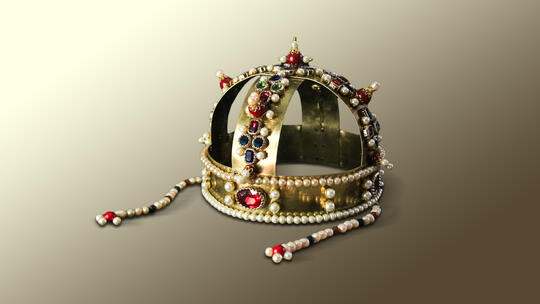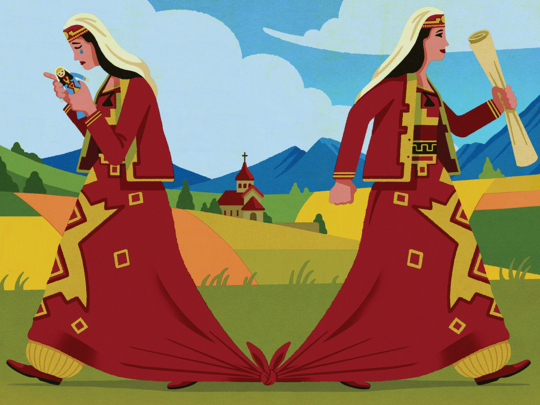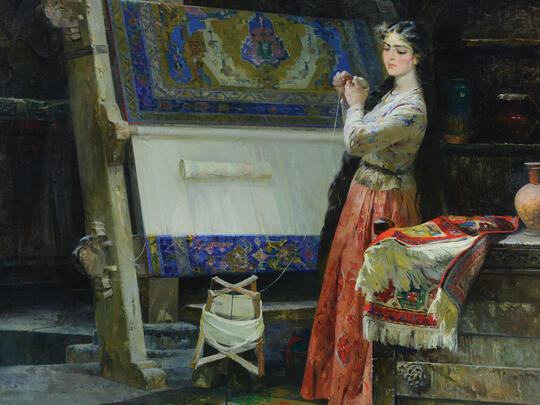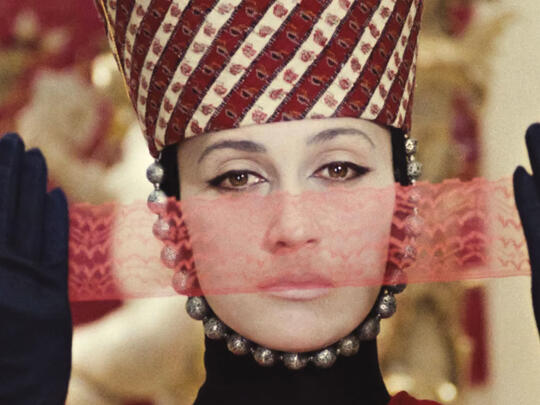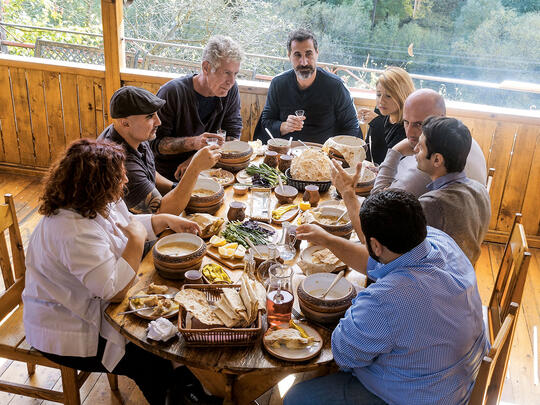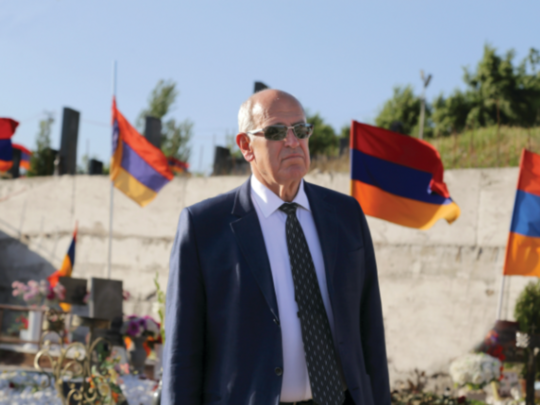Those in the forefront of today’s international women’s empower-ment movement cannot move away from the past fast enough. Yet for Armenian women, turning to the past is an opportunity to find the strength and encouragement to not just pursue the rights they deserve, but actually to reclaim them.
Even without the benefit of surviving castles or fortresses from our ancient historical past, there are abundant historiographical references about the succession of Armenian queens, 150 in all, who were entrusted with responsibilities that allowed them to fulfill their potentials as thinkers, leaders, rulers, and nation-builders. It is important to note that while it was the king who bestowed upon his queen these rights, he also honored and supported her decisions throughout her reign. Some queens were able to demonstrate military prowess, others were considered wise Maecenas and skillful builders through their architectural, educational, cultural and artistic initiatives. Considered rulers by divine right, they enjoyed wide popular support among men and women alike.
As we explore the life and times of these extraordinary role models, we are reminded that female empowerment is more than an aspiration. For the Armenian woman, it is her birthright.
The Warrior Queen

Throughout Armenian history, many queens were not only loving mothers and wives, but also courageous warriors who would set aside their royal crowns and intricate gowns to go to battle and defend their homeland. One of the most famous examples of such bravery is Queen Parandzem. Born to a noble family in Syunik, she was known for her intelligence, honor, and beauty. She’s been regularly referred to as the most prominent queen of the Arsacid Dynasty of the Kingdom of Greater Armenia. After marrying the man she loved, they raised a loving and strong family together. However, fate took her life in a different direction as she suffered much loss and heartbreak. After her husband’s execution, due to a plot of betrayal and treachery, she married King Arshak II, became queen and was known as “First Lady Paradzem,” giving him one son, Prince Pap.
In 368, after the Persian king Shapur II imprisoned the King, he thought it would be easy to conquer the Artagers fortress without its King at the throne. Clearly, he underestimated the power and courage of the Queen. Queen Parandzem gathered her royal army of 11,000 men and 6,000 women who daringly fought the Persian army of 50,000. After winning several battles, she gave hope to her soldiers and was even able to overturn the traitors. Her power was undeniable and she emanated encouragement as she empowered her people. Successfully defending her castle from Persian invasion for 14 months, an unfortunate epidemic broke out and caused her to lose her entire army. In the fifteenth month of battle, Queen Parandzem devastatingly conceded defeat and was left with no choice but to open the gates to her castle. As she stood alone on the last dawn of her reign, she was captured, tortured and humiliated at the hands of Shapur II, and publicly executed. Many chronicles have been written about Queen Parandzem, including accounts by 5th century Armenian historian Faustus of Byzantium, 4th century Roman historian Ammianus Marcellinus, as well as prominent 5th century Armenian historian, poet and writer, Movses Khorenatsi.
Throughout Armenian history, many queens were not only loving mothers and wives, but also courageous warriors who would set aside their royal crowns and intricate gowns to go to battle and defend their homeland.
Queen Parandzem was noted for being a brilliant diplomat and is remembered as a loyal and courageous leader who gave her life for her country and raised one of the most remarkable Armenian kings. From his youth, she instilled in Prince Pap that his priority should not be restoring the Arsacid Dynasty but rather strengthening the Kingdom of Greater Armenia. After taking the throne at age 16, the new king carried out his mother’s wishes by not only raising the standard of living through his numerous reforms but also establishing an independent Holy See of the Armenian Church in Greater Armenia and retaining Christianity as the official religion of the state. It has been often said that it is due to Queen Parandzem’s savoir-faire, bravery and self-sacrifice that Greater Armenia continued to exist.
During the 1990 Artsakh Liberation War, an all-female military unit called “Parandzem” was established to pay homage to the freedom-loving soul of such a heroic Armenian queen.
The Art Lover Queen

The niece of King Smbat I of the Bagratuni dynasty, Tamar was a lover of calligraphy, art, and floral design. Already a noble herself, upon her marriage to King Gagik Artsruni, she became known as Queen Mlke. As all royals, Queen Mlke was brought up learning various types of art from a very young age—needlework, calligraphy, embroidery and music.
Though royals had tailors who would sew their custom apparel with precious materials, Queen Mlke would embroider marvelous work on her own, her husband’s and her children’s clothes. She even enjoyed embroidering royal tablecloths. Manuscripts show that the work made by queens and noblewomen were so valuable that they were often traded for money and weapons. These embroideries would include pearls and other precious stones. In fact, the Katoghike Holy Mother of God Cathedral of Ani that was built by Queen Katranide II displayed many of these needlepoints.
Historians have noted that popular pastimes included meticulous needlepoint with threads of gold and handcrafting. The gold threads would be mixed with various flora and then embroidered into silk and other precious materials. Noblewomen would create such high-quality dresses that these clothes became works of art. In 1217, Marco Polo was so amazed with the woven work of Armenian women that he stated that the most amazing and beautiful silk weaves come from Yerznka, Armenia. The needlework and embroidery by the women of Van Vaspurakan was passed down to generations, showcasing the precise technique of these original pieces. This form of art later became popular in Cilicia, Crimea, Constantinople, Cappadocia and beyond and the exquisite work was credited to the women of Van.
Queen Mlke also enjoyed writing and kept her favorite manuscripts and gospels in her chambers. She was famous for preserving gospels and old Armenian books and creating copies of them. In 922, she noticed a missing manuscript and searched for it for months with her husband, King Gagik Artsruni. They offered rewards for anyone who would find it and, when finally did, they gave away her jewels and handworks. Commoners were so impressed by her relentless search for the gospel and donating her treasures to find it that they dubbed the manuscript the “Mlke Gospel.” She spent countless nights replicating it by hand and returned it to Varag Monastery’s Church of St. Mary, with hopes of it being safe. Unfortunately, after 1208, it was lost and found several times with at least seven reports of theft. Since 1830, the Mlke Gospel has been secured at the book depository of the St. Lazarus Mkhitarist Order in Venice. Mlke’s collection is extremely valuable and is comprised of 464 lambskin pages filled with Mesropian letters and is the oldest surviving Armenian illuminated gospel manuscript.
During her reign, arts and crafts became the heart of Van Vaspurakan and the peaceful independence period lasted over a century—making it possible for the Armenian Nation to produce creations that withstood the test of time. Historical events were documented and preserved, calligraphy and Armenian miniatures (illuminated manuscripts were mastered. It’s been said that no art school could compete with Van Vaspurakan. Around 1,500 handwritten manuscripts were created to teach future generations about color and form, the sun and the moon, and included words of wisdom from the living and immortal gods. These manuscripts tell us a story about a queen who was loved and cherished by the nation, yet she, herself, was the one who cherished the gospels.
Queen Mlke also played a major role in governing the Van Vaspurakan kingdom. She was wise to know that time may erase the names of kings and queens but their deeds will live for centuries. In honor of her husband, she commissioned the construction of Varag’s Church of St. Mary, which stood strong until the Armenian Genocide, serving as the symbol of devotion to her family. In 915, King Gagik honored Queen Mlke by commissioning the world-famous architectural jewel known as the Church of the Holy Cross on Lake Van’s island of Akhtamar, which took six years to complete. The exterior of this one-of-a-kind cathedral is adorned with unique carvings and etchings and the interior walls are adorned with paintings that pay homage to the outstanding role Queen Mlke played in development of the Van Vaspurakan kingdom. Though the Church of St. Mary may not be standing today, the contribution Queen Mlke made to Armenian arts and crafts along with the manuscripts that she fought to preserve has stood the test of time and are among the Armenian Nation’s national treasures.
Many have heard a fairy tale about Akhtamar and a nobleman whose boat capsized, but history captures a different tale—one that is much more consistent with the powerful story of King Gagik and his Queen, Mlke Tamar of the Vaspurakan kingdom.
The Pious Builder Queen

Queen Katranide II married King Gagik soon after he took the throne following his brother’s death. She was the daughter of King Vasak I and Queen Shahandukht II of Syunik. Born into a royal family, she became the Lady of Ani and played a key role in the realms of economics and construction.
In 989, King Gagik’s brother King Smbat II began the construction of the Katoghike Holy Mother of God Cathedral of Ani. His death paused the construction until Queen Katranide had an epiphany to see its completion. It has been said that an angel appeared to her and gave her the strength to finish the project and assured her that it would remain until the second coming of Christ. Queen Katranide commissioned Trdat the Architect, who is famously known for rebuilding the dome of Hagia Sophia, to bring the project to fruition. She sold her dowry, wedding gifts, and precious gems and spared no expense to complete the Cathedral in 1001. According to historians, she adorned the interior with needlepoints and tapestries embroidered with purple flowers interwoven with gold and silver. The Mother Cathedral was the most striking structure of the capital with its lofty vaults and arches. In fact, architects and scholars believe that Gothic architecture originated from this 10th century church.
The Katoghike Holy Mother of God Cathedral of Ani served as the seat of the Catholicos for nearly half a century, along with the entire site of Ani–known as the city of 1,001 churches. It was declared a World Heritage Site by the UNESCO in 2016.
Queen Katranide built and renovated many other monasteries, monuments and churches but they have been deplorably destroyed by the Turkish government that continuously aimed to eradicate the presence of historic Armenia as part of its ongoing cultural genocide.
It has been noted that in 1893, while the Kingdom of Ani was part of the Russian Empire and archaeological investigations became possible, Queen Katranide’s tomb was exhumed. Her skeletal remains shocked the archeologists upon noting that her legs were crossed at the ankles as that of Jesus Christ, an indication.
The Scholar Queen

In 1219 Cilicia, King Leo the Magnificent (1187-1219) designated that, upon his death, his daughter Zabel be named heir to the throne. At just 4 years old, she ruled the kingdom under the regency of her noble guardians and went on to become one of the most powerful and famous queens in Armenian history.
Queen Zabel had a rigorous educational upbringing. Education of royal family children was common and very important amongst the nobility. More attention was paid to the girls, who were brought up by devoted live-in tutors and scholars who would prepare them to become future rulers of the nation.
Much like other queens, Queen Zabel’s fate led her to serve her country. In 1222, the royal court of Cilicia arranged the marriage of a then 7-year-old Queen Zabel with Philip, the 17-year-old future prince of Antioch. Understandably, this marriage was an arrangement made to strengthen political ties as it had been Queen Zabel’s late father’s strategy to forge alliances with Christian states of the Orient in order to control and balance the Muslim powers that surrounded the Kingdom of Armenia. Though strict conditions were set for Philip to respect Armenian customs and rule by the law of the land, Philip went back on his word and broke the agreement with an attempt to send the royal crown to Antioch.
For this betrayal, Queen Zabel’s guardian was forced to imprison him. Without yet recovering from this emotional turmoil, the now 10-year-old queen was forced to marry her guardian’s son, Hethum I. That union began the Hethumian dynasty. During their 25-year marriage they had eight children. Their currency depicted King Hethum with Queen Zabel on one side and their coat of arms on the other, signifying that they are equals and each holds significant power.
Queen Zabel was regarded as a very caring person. She continued what her father started by nurturing the education of her people and played a significant role to promote literacy, art, preservation of manuscripts and translation of books. Under her reign, many monasteries and schools were opened and she would invite scientists and scholars to teach scientific and religious disciplines. Painters, poets, translators, and artists were empowered and were producing new works through the patronage of the royal court while the royal treasury funded the education of countless youth.
Outside of education, the health of the people was very important to Queen Zabel. In 1241, she opened the first hospital in Cilicia which was also the first public hospital in all of Europe. She and her children would personally help care for the sick and she would invite physicians from the kingdom to treat patients and administer medications. This was unusual yet extraordinary in medieval world history since the hospital was free of charge and tended to the needs of the poor.
Queen Zabel reigned for 33 years and died at the young age of 37. King Hethum commemorated his wife’s memory by commissioning the build of the
Church in Greater Armenia and retaining Christianity as the official religion of the state. It has been often said that it is due to Queen Parandzem’s savoir-faire, bravery and self-sacrifice that Greater Armenia continued to exist.
During the 1990 Artsakh Liberation War, an all-female military unit called “Parandzem” was established to pay homage to the freedom-loving soul of such a heroic Armenian queen.
The Philanthropist Queen
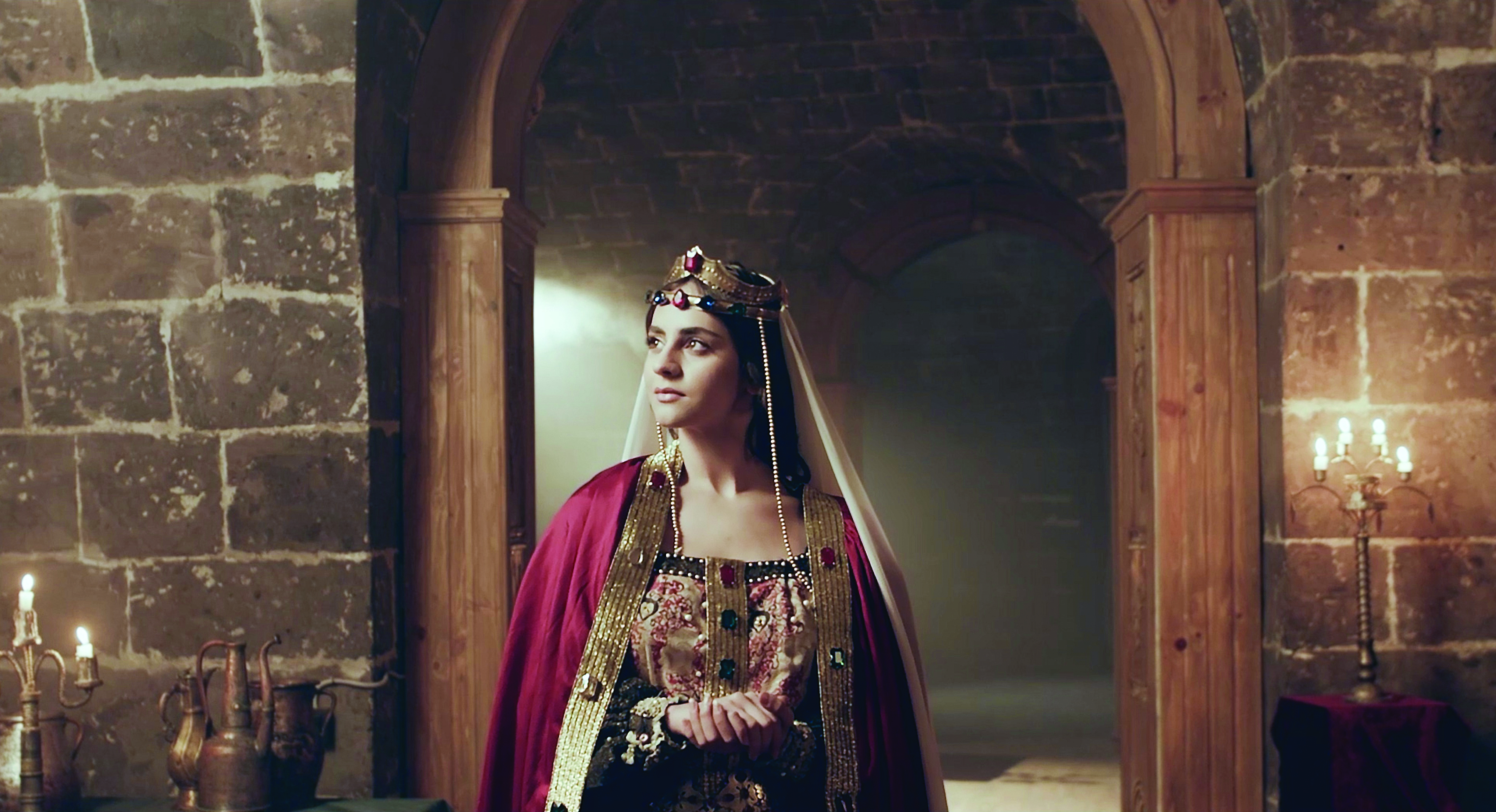
Just four years after her marriage—which was arranged to forge an alliance between two dynasties and end a bloody feud—Queen Keran did not hesitate to offer her treasures and possessions for the salvation of her husband, who was taken prisoner by the Mamluk invasion during the Battle of Mari in 1266. Queen Keran ruled beside King Leo III, the son of Queen Zabel and her successor to the throne. Known for having the most children than any other Armenian queen, Queen Keran birthed 15 children, five of whom later became Armenian kings and were the only brothers who succeeded each other to the throne. In honor of the king’s late mother, three of their daughters were given different variations of her name—Zabel, Zablun and Sipil.
Referred to as the “Most-Glorious Queen,” Queen Keran was loved by her people and known for her charitable work and special care for the poor. She would give them clothing, food, jewelry, dinner sets, and even gardens. Armenian manuscripts refer to her as the patroness of arts and sciences and as someone who commissioned the writing of many manuscripts to keep historical events alive.
The gospels and manuscripts commissioned by Queen Keran are considered masterpieces of medieval art and are kept in the library of the Armenian Monastery of St. James in Jerusalem as well as in the Matenadaran in Yerevan. The great Armenian miniaturist, Toros Roslin, painted a miniature portrait of Queen Keran and King Leo while his illuminated manuscripts and art directed the beginning of Cilicia’s Golden Age. The second half of the 13th century was considered to be the highest point in the development and flourishing of Armenian art, crafts, miniature paintings in gospels and illuminated manuscripts. With Cilicia geographically situated at the crossroads of trade and economic life, one could find the best in all spheres of art there. Wealthy Armenian tradesmen were importing and exporting beautiful fabrics, precious stones, gold and silver. The queen and king built hotel-like dwellings to provide a place for tradesmen, travelers and even the needy to eat, spend the night and rest. Queen Keran has been praised by many for having a wonderful soul and a kind heart. Despite having 15 children over her 20-year marriage, Queen Keran chose to become a nun and entered the Monastery of Drazark, where she resided until her death.
The Politician Queen

In the foreign policy of the empire in the ancient world, the Armenian queen enjoyed the respect and reverence of foreigners due to her intelligence and will. There are few nations in history that have given power to women, allowing them to play a major role in domestic and foreign affairs. The participation of the Armenian woman in politics is more multifaceted than that of other famous women rulers throughout history, where her title was equivalent in stature to the King’s. She had equal rights to participate in royal meetings and to accept or reject political proposals. She made fateful decisions, was not afraid of the large enemy army and was able to defeat the adversary with intelligence and diplomacy.
Queen Mariun was the last renowned queen of the Kingdom of Armenia. She embraced her role as ruler and had no qualms about doing what was necessary to reach her goals. In 1362, Queen Mariun lost her husband King Constantin IV (III). They had two children but both died at a young age. She was alone but remained strong and proudly ruled the country until King Constantin V (IV) took the throne. Even during the reign of the succeeding king, Queen Mariun continued to play an active political role. Heading the Council of Elders dissatisfied with the king, she sought help from Pope Gregory XI, secretly negotiated with European rulers, bent them to her side, and after the assassination of the king, ascended to the throne again for the second time, successfully restoring her right to power for another 15 months. She was the guardian of Cilicia, a beloved queen of the country who had kept the throne unshakable for many years. A miniature portrait she had commissioned in 1346 lives on in a manuscript by famous early 14th-century Armenian artist, Sargis Pitsak.
After the fall of the kingdom in 1375 when Cilicia lost the capital city of Sis in battle to the Mamluk army, Queen Mariun was taken prisoner in Cairo. Upon being freed from captivity, she went to Jerusalem and spent the last years of her life as a nun in the Armenian Monastery of Saint James. Historians refer to Queen Mariun as a great politician, smart diplomat, and brilliant leader who would give her life to fight against the invaders and was respected not only in her country but also in other royal courts.
Armenian queens have tremendous accomplishments under their royal belts and have set the foundation for future female leaders. Regrettably, many other names of brave Armenian queens who ruled are unknown to us because they were captured, tortured and killed as they courageously fought alongside their husbands to protect their country. It is imperative to preserve this piece of history and recognize the exceptional accomplishments of Armenian women, and continue to celebrate them in the light of leadership, triumph, wisdom and power. Their resilience has given them the strength to not only rule lands but to overcome atrocities, maintain their mother tongue, and instill their heritage, culture and customs in their children. Though for centuries the enemy destroyed their cities, churches, castles, cross stones, manuscripts and gospels, the contributions and kind deeds of Armenian queens live on.
AGBU supported The Crowned docuseries with a Young Visionaries Mini Grant and has since produced an English version of a select episode. Watch an introduction to the royal world of Armenian queens in all its splendor, intrigue and female power.

